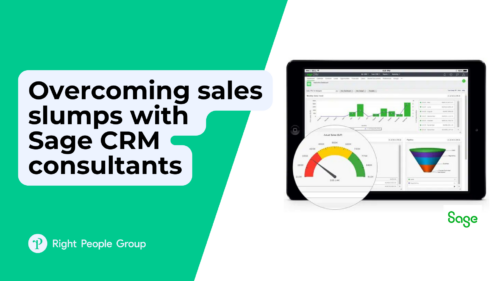Implementing SAP software can transform your business operations, enhancing efficiency and productivity. But it’s not a simple task; it involves intricate steps and potential obstacles.
This guide gives IT leaders five clear steps to streamline SAP implementation and make the shift to better business operations.
Strategy 1: Align with business objectives from the outset
When starting an SAP implementation, it’s easy to get caught up in the technical details.
But before you go down that road, take a step back and focus on your business objectives.
Starting with a focus on business objectives will not only guide your SAP implementation but also ensure that the new system brings value to your organization.
Set clear goals: Before anything else, define what success looks like for this project. Whether it’s improving operational efficiency or enhancing customer experience, having clear objectives will guide your decisions throughout the project.
Get stakeholder input: Talk to people across different departments to understand what they hope to gain from the new system. This will help you create a well-rounded set of objectives that serve the entire organization.
Map objectives to features: Once you have your objectives, match them with the features or capabilities offered by different SAP solutions. This ensures that the system you choose directly contributes to achieving your goals.
Review and adjust: As the project progresses, keep revisiting your objectives to make sure you’re on track. If necessary, make adjustments to stay aligned with your business goals.
Strategy 2: Build a cross-functional project team
To ensure a successful SAP implementation, you need a well-balanced team with a diverse range of skills and expertise.
Among the benefits of a cross-functional project team are:
Full view: A team with different skills makes sure all parts of the project get attention, from the techy details to the business needs.
Getting things done faster: When people are good at different things, you can give tasks to those who can do them best. This speeds up the whole project.
Spotting problems early: A balanced team can see issues coming before they turn into big headaches. This is true whether we’re talking about integrating business processes or changing how your company is organized.
Here’s who you need with you on your SAP implementation journey:
Internal team members
Business process experts: These folks know your company’s operations really well. They get how your business objectives can be turned into technical needs.
Project management: A project manager keeps everyone focused and makes sure the project stays on track. They handle coordinating all the tasks, timelines, and resources.
IT specialists: Your in-house IT team will work closely with the SAP system every day. Their input helps make sure the system meets all the technical specs and works well with what you already have.
External resources
SAP implementation partner: A seasoned SAP partner knows a lot about the SAP implementation process. They can offer specialized skills your internal team might not have.
Consultants: If you need knowledge that neither your internal team nor your SAP partner can offer, consultants can step in.
Strategy 3: Opt for the SAP solution that fits your unique needs
The market offers a variety of SAP solutions, including SAP ERP, SAP S 4HANA, and other specialized ERP software. Your choice should align closely with your business needs and objectives. Here’s how to make a more informed decision:
Understand your business processes
Take stock of your existing business processes to identify what you really need.
Talk to different departments to get a full picture of what functionalities are essential.
Use this information to create a checklist of features that your new ERP system must have.
Research different SAP solutions
Look into the features and benefits of various SAP solutions like SAP ERP and SAP S 4HANA.
Match these features with your checklist to see which SAP software aligns best with your needs.
Don’t forget to consider how each solution can support your broader digital transformation goals.
Consult with an SAP implementation partner
An SAP implementation partner can offer expert advice on which SAP solution best fits your organization.
They can guide you through the key stages of the implementation process, making it easier for your project team.
A good partner will also help you understand how to align the new SAP system with your existing business processes.
Factor in future growth
Choose an SAP solution that meets your current needs but is also scalable for future business objectives.
Cloud services can offer this scalability and are particularly beneficial for large enterprises.
Consider how the SAP system can adapt to potential changes in your organizational structure and business needs.
Budget considerations
While it’s important to pick the most suitable SAP solution, you also need to keep your budget in mind.
Collaborate with your project team and SAP implementation partner to find a solution that offers good value for your investment.
Be aware of the total cost of ownership, which includes not just the software but also ongoing maintenance and potential upgrades.
Strategy 4: Embed change management into your company culture
When you’re introducing SAP systems, you’re also introducing a lot of change. This change can affect everything from daily tasks to overarching business processes.
Here’s how to manage these changes:
Training and communication
Open lines of communication: Keep your team informed about what’s happening at every stage of the SAP implementation process. Transparency helps to reduce uncertainty and resistance.
Skill development: Equip your team with the skills they need to use the new SAP system effectively. This can be done through workshops, online courses, or one-on-one training sessions.
Business continuity
Risk assessment: Identify any risks that could disrupt your business during the SAP implementation. Once you know what these are, you can develop strategies to mitigate them.
Contingency plans: Always have a backup plan. Whether it’s data loss or system downtime, know what steps you’ll take to ensure business operations continue smoothly.
Organizational adaptability
Flexible structure: Your organizational structure might need some tweaks to accommodate the new SAP system. Make these adjustments ahead of time to ensure a smooth transition.
Employee involvement: Involve employees in the decision-making process. When people feel like
Strategy 5: Adopt a continuous testing approach
In an SAP implementation, continuous testing is key from start to finish. It helps you catch issues early, ensures your SAP system integrates well with other business systems, and lets you make smooth adjustments to keep your business running effectively.
How to implement continuous testing effectively
Develop a testing plan: Before you start, outline what needs to be tested, how it will be tested, and when. This plan should be part of your overall project management strategy.
Involve the right people: Your implementation team should include members skilled in software testing and quality assurance. They’ll be responsible for carrying out the tests and ensuring that the system meets all requirements.
Use real-world scenarios: When setting up your tests, use scenarios that mimic real-world conditions as closely as possible. This will give you a better understanding of how the SAP system will perform under actual operating conditions.
Automate where possible: Automation can speed up the testing process and make it more efficient. However, manual tests are still important for areas that require human judgment.
Review and adjust: After each testing phase, review the results and make any necessary adjustments to the SAP system or your testing approach.
Additional considerations
The main strategies get you started, but there’s more to consider for a truly successful SAP implementation. Here are some extra tips to help you dot the i’s and cross the t’s on your project.
Use cloud services to easily scale up or down
Cloud services are your friend when you need to adjust your resources. This is a big deal if you’re a large enterprise with changing needs during your SAP project.
Keep a tight grip on project management
Don’t just set it and forget it. Keep an eye on how your SAP project is going with regular check-ins. Make sure you’re still aiming for what your business really needs.
Bring in outside experts
If you find gaps in your team’s skills, it’s okay to look for help from outside. External experts can fill those gaps and keep your SAP project moving forward.
Make sure your new system plays nice with your current processes
You’re adding a new ERP system to make things better, not harder. So, plan out how this new system will fit into what you’re already doing.
Don’t skimp on moving and checking your data
Your data is the star of the show in any ERP system. Make sure you migrate data carefully into your new SAP system. And double-check that it’s accurate, because it’ll affect everything from reports to how you talk to your customers.
Conclusion
A successful SAP implementation isa strategic initiative that can transform your business. Align your goals, pick the right team and SAP solution, manage change well, and test continuously for a successful setup and a better business.
Looking for skilled SAP consultants?
If you need an SAP consultant to guide your project to success, Right People Group is here to help. We’ve been matching businesses with specialized IT and business consultants since 2007. Our consultants are vetted for their expertise and their ability to deliver results affordably.
Get in touch with us, and we’ll find you an SAP consultant who fits your project just right.













